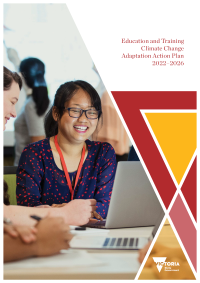The Education and Training Climate Change Adaptation Action Plan is one of 7 plans prepared by the Victorian Government for 7 statewide systems. The plans will help ensure Victoria’s climate resilience, now and into the future.
The challenge
The Education and Training system includes the people, places and services involved in life-long learning. It serves at least one-third of Victorians every year across the early childhood, school, higher education, and training and skills sectors.
The Education and Training system is already affected by extreme weather events, and rising temperatures will challenge the system’s workforce, learners, services and built assets. Key risks include threats to the health and safety of students and staff, damage and increased maintenance and recovery costs to schools and facilities, and disruptions to service provision and learning.
The system is also central to supporting Victorians to learn about climate change and how we can build our climate resilience. Climate change is a major concern for young people – it is affecting some young Victorians’ mental wellbeing, and children are especially vulnerable to climate impacts. Children in their early years of school have never experienced a below-average year in temperature – every year from 2013 to 2020 has ranked among the warmest years since Australian records began in 1910.
Work already underway
- Partnering with state, regional and local emergency management to comprehensively manage risks, prepare and plan, respond to and recover from extreme events. Providing heat health alerts, advice and wellbeing guidance for schools to respond to extreme hot weather, heatwave events and bushfires.
- Requiring all schools to comply with Victoria’s bushfire preparedness guidelines and requiring registered Bushfire At-Risk schools and early childhood services to pre-emptively close on days declared as ‘Code Red’ in their districts.
- Supporting education and training providers to incorporate climate change into teaching and learning.
- Delivering facilitated workshops and developing e-learning modules to provide school leaders with emergency management information and guidance.
- Integrating environmental sustainability as a priority outcome in early childhood education, as a cross-curriculum priority in the Victorian Curriculum, and in whole-school action through programs such as ResourceSmart Schools.
Key priorities ahead
The next 5 years (2022–2026) will be focused on ensuring that decision-makers, educators and learners have the information, tools and capacity to respond to current and future climate impacts, particularly those related to health and wellbeing, and infrastructure and assets.
- Improving educators’ and learners’ ability to understand climate risk and embed adaptation in their everyday decisions.
- Identifying climate risks to the school asset portfolio and integrating adaptation into Victorian School Building Authority policies.
- Investigating how the early childhood education sector can be supported to build the climate resilience of early learning and kindergarten infrastructure and operations.
- Preparing a plan to address thermal comfort-related climate change impacts in Victorian Government schools.
- Making assets more resilient by incorporating locally tailored training and resources (such as flood overlays and temperature and rainfall projections) into land use planning, site selection for education services, and capital works.
- Working with adult, community and further education providers to identify climate change-related learning barriers and build adaptation knowledge and skills.
Further information
| The Education and Training Climate Change Adaptation Action Plan will be delivered over the next 5 years (2022–2026), then updated every 5 years on the path to 2050. Read the full Adaptation Action Plan for the Education and Training system |
Page last updated: 15/02/22
